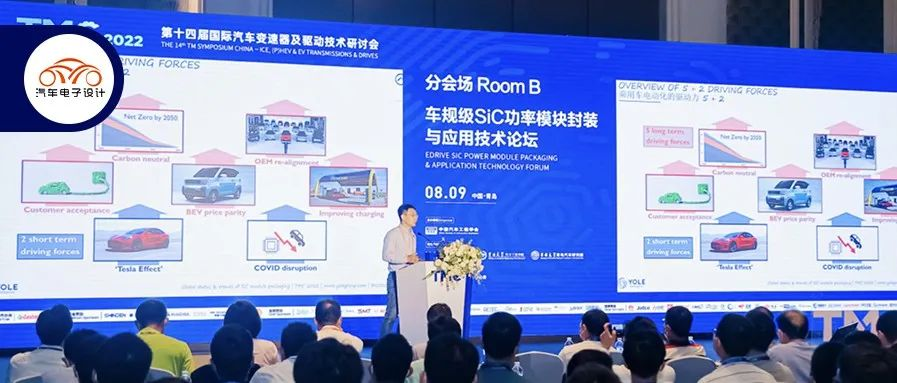Author: Zhu Yulong
Recently, I attended the TMC forum on car-grade SiC power modules in Qingdao. As mentioned earlier, with the conversion from 400V to 800V bus, the SiC industry has become a very promising industry and occupies a very important position in China.
This TMC forum made a very good attempt to establish communication channels between car companies and SiC companies. Here, I will summarize and record some of the highlights from the first half of the forum.
First Half
- Moderator Cai Wei, a foreign academician of the Russian Academy of Engineering, chief scientist of the Ministry of Education’s Engineering Research Center for Automotive Electronic Drive Control and System Integration, and Professor of Harbin Institute of Technology.
Currently, the price of silicon carbide is approximately three to five times that of IGBT, and recently, silicon carbide suppliers have further increased their prices (due to chip shortages). It is expected that by 2027-2030, silicon carbide will become mainstream, with over 70% of automotive companies testing or trialing at least one silicon carbide model next year.
Currently, a large amount of packaging materials rely on imports, especially high-temperature resistant materials, including insulating packaging materials, and the goal is to have self-produced silicon carbide chips combined with self-packaging by 2025.
- Yang Yu, Senior Analyst at Yole Développement
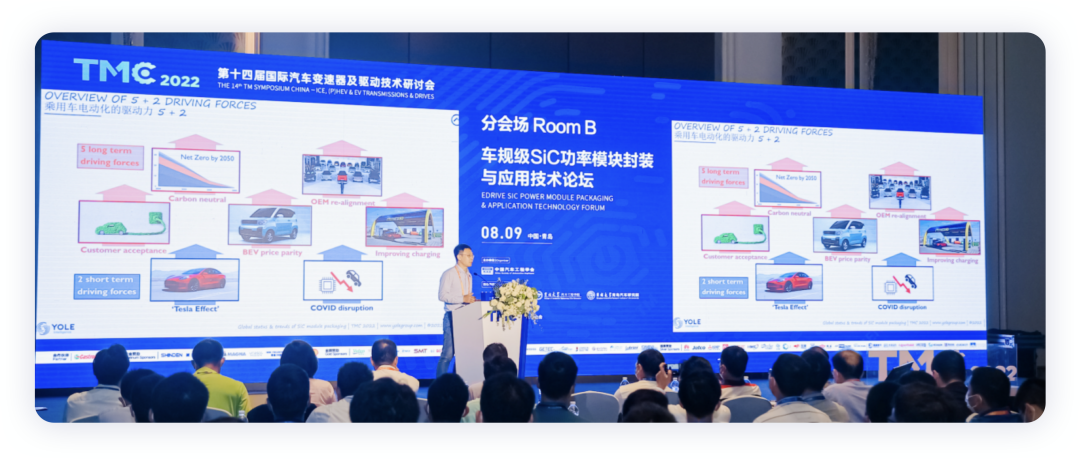
The market demand for silicon carbide (in terms of market value, not quantity) is expected to grow rapidly in the next few years, but silicon-based devices will not be phased out so quickly due to the high cost of silicon carbide. Although silicon carbide and 800V are a relatively good combination, it is not a one-to-one relationship. In the early days of the 800V system, silicon-based IGBT was still used because the silicon carbide device was not yet mature. Currently, most of the silicon carbide still uses existing silicon-based technologies and packaging techniques, which can avoid the uncertainty in the SiC market and ensure technological maturity. The focus is to get the silicon carbide module up and running and then optimize it.
To fully take advantage of the benefits of silicon carbide, the following work can be done:
-
Cooling: Currently, the mainstream is single-sided direct water cooling, but silicon carbide is better suited for double-sided water cooling. Most of the current silicon carbide devices are platfom based, with a narrow range of heat generation but very high heat, which puts higher demands on cooling.
-
Silver sintering technology packaging has a relatively high temperature and can overcome packaging reliability issues. Silver sintering technology can be used for bottom connection and different positions. Copper sintering may achieve an all-copper module.- Bonding technology: In order to operate at relatively high frequencies, Silicon Carbide requires a very low inductance technology. A novel bonding technology can be used, which is flexible (like PCB bonding) and covers the entire board like leads, directly soldering it to the surface, which is a relatively new bonding technology.
-
High temperature encapsulation materials: Operating at high temperatures may require new materials to adapt to its system.
-
Substrate: In terms of thermal expansion technology differences from CTE, both aluminum nitride and silicon nitride are good materials, which are relatively close to the thermal expansion technology of silicon carbide. However, the toughness of aluminum nitride is insufficient, making it easy to break, and it is preferred to use copper-rich aluminum nitride materials.
What makes Silicon Carbide unique is the variety of materials, many of which are being developed by innovative companies. In the future, it will be crucial for traditional power semiconductor companies to vertically integrate through acquisitions. Due to the special properties of the material, IDM has an advantage, and the ratio of Silicon Carbide and silicon used in the entire cost is about 2.5:1, which may gradually decrease to about 2 in the next few years.
- Wang Dongcui, Chief Engineer of MCU Control, Shanghai Jieneng Automotive Technology Co., Ltd.
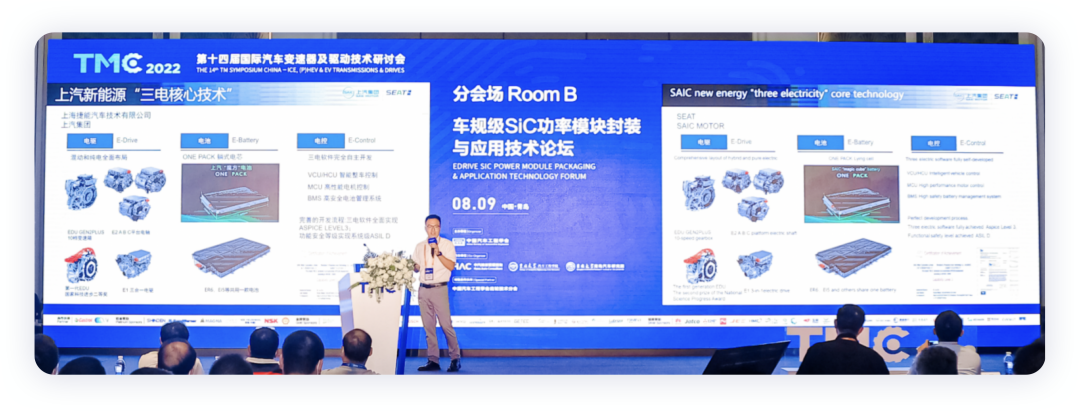
SAIC’s entire 800V series includes an 800V fast-charging battery, with a front-wheel A-axis and a rear-wheel C-axis, including a high-voltage PDC. The weight of the electric drive system has increased by 4%, and the weight power density can be increased by 60%. The cost of the electric drive system has increased by about 30% due to the expensive cost of Silicon Carbide devices. The efficiency contrast of the C-axis at 400V and 800V showed that the high-efficiency area clearly increased, with a 6.6% increase in the 90% efficiency area and a 7% increase in the 95% efficiency area. Silicon Carbide is more suitable for CLTC working conditions, and the average efficiency has increased by 3%-5%.
The electric drive control integrates MCU+VCU+BMS partial functions, adopts Aurix TC389 main control chip, and is equipped with SBC3584 to achieve functional safety, and some functions of the vehicle-side BMS have been added.In different working conditions including low, medium and high speed, there would be an optimal efficiency point for the application of silicon carbide system. The high-speed situation at 2.1 million revolutions per minute can also be controlled at a frequency of 10,000 Hz. When the frequency is raised from 10,000 Hz to 12,000 Hz, the fluctuation significantly decreases. After the application of silicon carbide, the motor can be controlled to reach a situation of 25,000 revolutions per minute. By increasing the frequency of silicon carbide switch by 20% to 30%, the speed can be further increased. By making the frequency high based on silicon carbide power devices, significant optimization can be observed from 13,000 Hz and below, and at 15,000 Hz, 16,000 Hz, and 17,000 Hz. The high-speed switch feature of silicon carbide requires precise design, and it also leads to a significant impact on EMI caused by higher switch. The root of axial voltage is the capacitance-induced voltage caused by PWM switch, which can be optimized through the source, the path, and comprehensive optimization of the bearing itself.
Ning Puqi, a researcher of the Electric Vehicle Research Department of the Institute of Electrical Engineering of the Chinese Academy of Sciences, stated that silicon carbide devices need to:
-
Breakthrough the high-temperature limit and operate stably at 200 degrees
-
Solve the problem of easy interference under high-speed switch and achieve high-speed gate level drive
-
The heat dissipation is too concentrated and requires efficient heat dissipation methods.
Li Zhiwen, Innovation Director of the New Energy Technology Division, Asia Pacific Region of Weipai Technology Investment (China) Co., Ltd., stated that the first-generation silicon carbide power module that is close to batch production is a frame + potting type silicon carbide power module. Meanwhile, a silicon carbide module embedded in the PCB pipe is feasible, and a generation of products that can be put into mass production will be realized in five or six years.
To obtain the lowest motor loss under WLTP working conditions, the optimal switching frequency can be found based on different speeds and torques, and using only silicon carbide inverters can reduce power consumption by 4.5 Watt-hours/kilometer. By using the optimized switching frequency, the power consumption from the inverter end rises, but from the perspective of the motor, it further reduces by 0.55 Watt-hour/kilometer. The combined optimization of the motor and inverter leads to a power loss reduction of 0.4 Watt-hour/kilometer, in addition to the reduction in switch loss and conduction loss of the silicon carbide inverter, resulting in a total power loss reduction of 4.9 Watt-hours.6. Wang Lei, Technical Manager for New Projects in the Asia-Pacific Region, BorgWarner China Technical Center
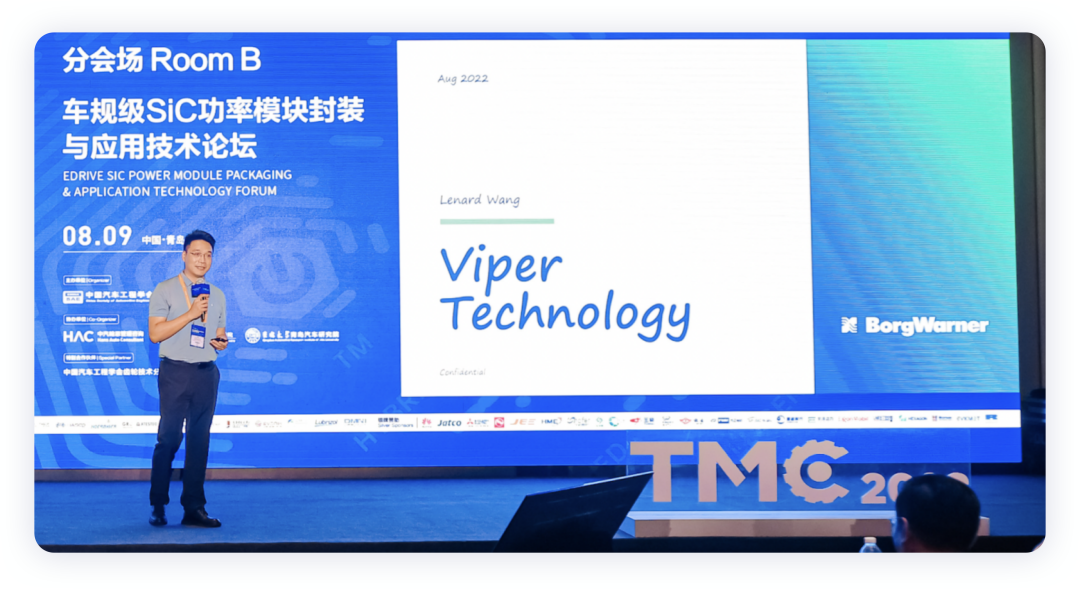
The Viper design was originally intended to eliminate failure points in wire bonding, improve thermal conductivity, and simplify packaging in order to reduce overall design and manufacturing costs and increase feasibility.
The main application of Viper is to improve current density and junction temperature. The double-sided water-cooled packaging design is optimized for thermal management while minimizing the use of expensive wafers, ultimately reducing the overall system cost.
Double-sided water-cooling, lower thermal conductivity, and controlled junction temperature are key features of Viper. By using fewer wafers in terms of size and quantity, the overall cost is reduced.
Based on reliability considerations, wire bonding was eliminated in the design, and instead the module is assembled by welding or encapsulation, resulting in higher energy density.
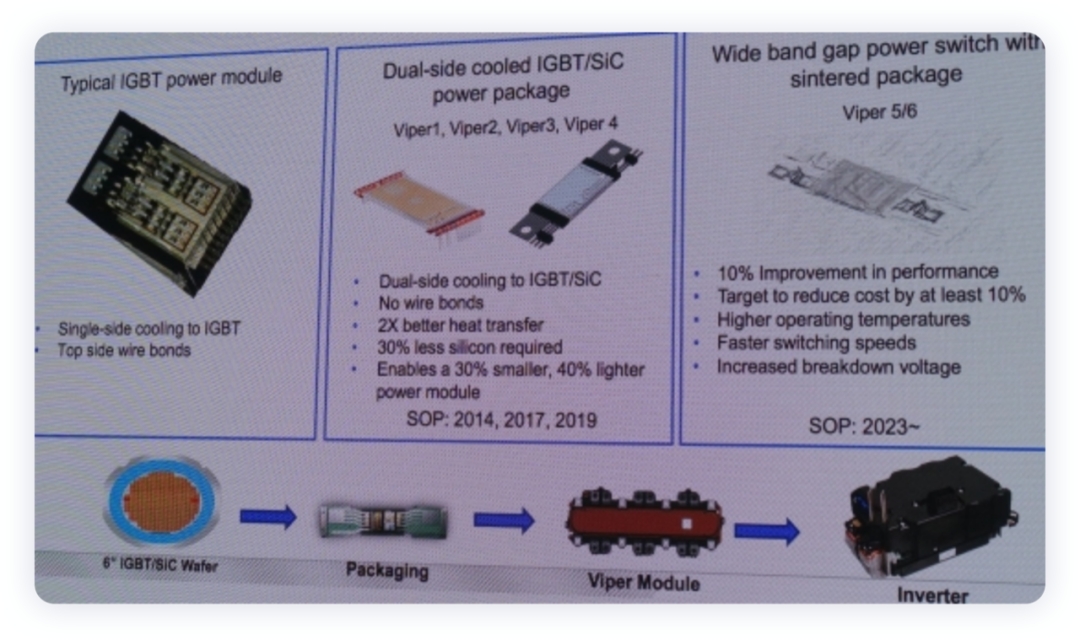
- Zeng Sixiong, R&D Director of Power Electronics Product Line, China Region, Faurecia Powertrain
I will not quote anything here about charging stations.
- Shen Dongyan, Technical Support Manager for Bosch Automotive Electronics China
The first generation of traditional flat silicon carbide (SiC) structure is currently the mainstream. Bosch’s double-groove SiC extends longitudinally, effectively reducing the pitch between devices. The double-groove technology also improves the current density and reduces the inter-device distance. Under the same ambient temperature, the groove-type SiC products are much smaller in the same surface area than the traditional flat SiC. The optimization of reliability also ensures higher performance of the SiC product.
Bosch’s first-generation SiC products of 1200V and 750V have already been mass-produced. The development of the second-generation product is underway, and samples of the 750V product have been produced, with the plan to begin mass production by 2023. The second-generation SiC products will have the following enhancements:
-
The temperature coefficient can be reduced by 10%.
-
By integrating a diode, the high voltage drop produced by the entire SiC switch control process can be reduced by 50% compared to the first generation, making it possible to support faster switching speeds.
Summary: This forum is very rich in content, so it is divided into two parts, with the second part to be organized tomorrow.
This article is a translation by ChatGPT of a Chinese report from 42HOW. If you have any questions about it, please email bd@42how.com.
